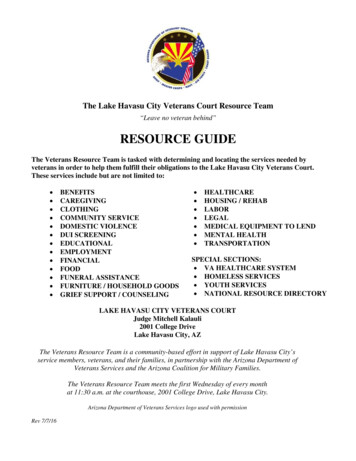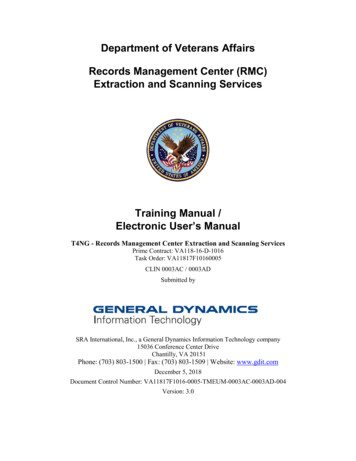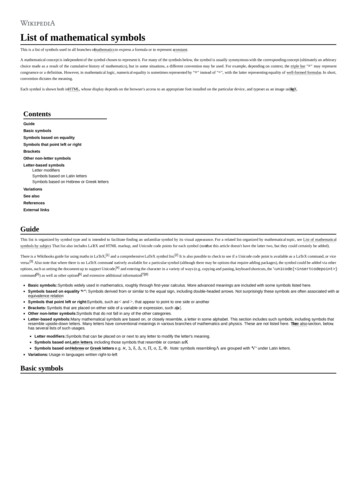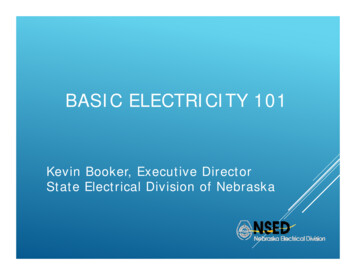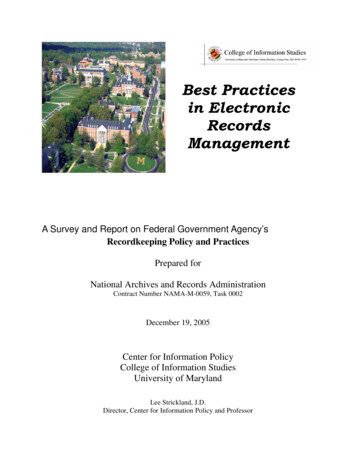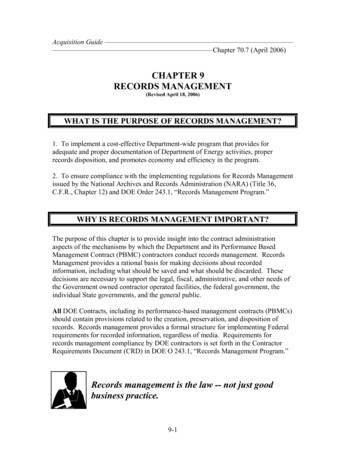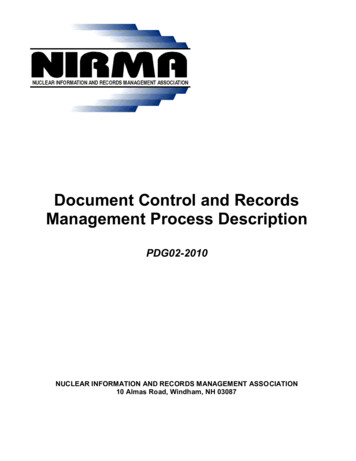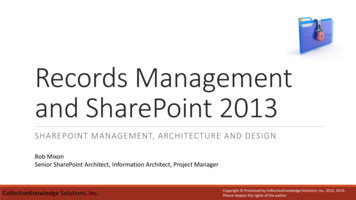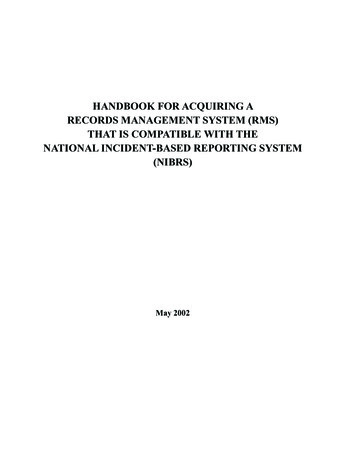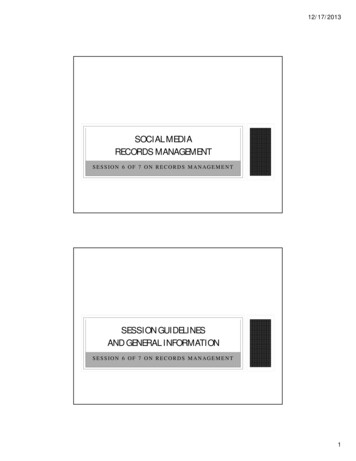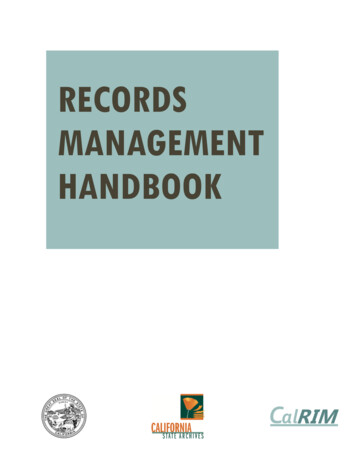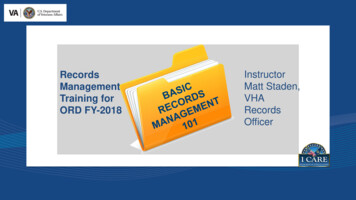
Transcription
RecordsManagementTraining forORD FY-2018InstructorMatt Staden,VHARecordsOfficer
VA Records StructureDefine what is a recordIdentify basic categories of recordsDetermine the significant differencesamong records, non-record materialand personal papers Record Management areas of concern Key position responsibilities Define File Plan/Records Inventory
Records Program StructureVA RecordsManagementSam NicholsVA VACOProgram OfficesVarious Records LiaisonsVBAVHANCADwayne JonesMatt StatenMichele Power
What is a RecordAll media forms to include, but not limitedto, books, papers, maps, photographs,machine readable material, or otherdocumentary materials, regardless ofphysical form or characteristics, made orreceived by an agency of the U.S.Government under Federal Law or inconnection with transactions of publicbusiness (44 U.S.C. 3301)
VHA Records Life fe Cycle4Retain &Destroy2Use/Send3File &Store
VHA Records Life fe Cycle4Retain &Destroy2Use/Send3File &Store
VHA Records Life fe Cycle4Retain &Destroy2Use/Send3File &Store
VHA Records Life fe Cycle4Retain &Destroy2Use/Send3File &Store
VHA Records Life fe Cycle4Retain &Destroy2Use/Send3File &Store
VHA Records Life fe Cycle4Retain &Destroy2Use/Send3File &Store
Records CategoriesRecords documenting the VHAunique, mission-related activitiesRecords documenting the VHAroutine housekeeping supportactivities. Known as GeneralRecords Schedule GRS
Paper RecordsElectronic RecordsPhotographic RecordsComputer Punch CardsCartographic RecordsArchitectural RecordsAudiovisual RecordsMicroform Records
Temporary, Permanent & Unscheduled RecordsRecords approved by NARA fordestruction after a specifiedretention periodRecords determined to havesufficient value to be preservedby NARARecords whose disposition has yetto be determined by NARA. Theserecords default to Permanent
Non-Record MaterialNon-record materials are excluded from legaldefinition of records by 44 U.S.C. 3301 and fall intosome of the following categories: Personal Papers Extra copies of documents Library and museum material, stocks of publications, catalogs,trade journals, & other publications Documents received that provide information but are notconnected to the transaction of agency business Routing slips & tickler files
Leaving Federal ServiceGovernment employees are required to take steps to ensure allFederal records are properly managed and preserved. Recordsmust be appropriately identified and captured from: Email, social media, or electronic messaging accounts All internal and external advisory boards, committees, or councilsin which you participated Reports to Congress and/or the President, speeches, testimonies,or major correspondence
Leaving Federal Service (Continued)Any removal of information is subject to review by officials from youragency. Approval should be granted only if all of the followingconditions are met: Removal would not adversely impact the official records of theagency Removal would be at no cost to the agency Materials do not contain classified national security information Information removed is not subject to the Privacy Act of 1974 (5U.S.C. 552a) Disclosure of the information removed is not otherwise prohibitedby law
Areas of Concern Personal E-mails Record Storage File Plans and Record Inventory Protection of Electronic Information Systems, Share Files andSharePoint Records
Use of Personal E-Mails In April 2015 the VA CIO, published a memorandum forbiddingthe use of personal e-mail to conduct government business. Fact Sheet was Created by the VHA records ManagementCouncil In January 2018 the VA OGC, published another memorandumagain limiting the use of personal e-mail accounts to emergenciesonly. It also added additional requirements for IM’s and textmessaging. Note; current OGC memorandum provided.
Records Storage VA including VHA must meet NARA guidelines on the storage ofActive and Inactive records. VHA records storage can be divided into 6 categories: Inactive records, off-site storageInactive records, on-site storageActive records, off-site storageActive records (low-usage), on-site storageActive records (high-usage), on-site storageTemporary/transit records storage Note; Records Storage Fact Sheet Provided.
File Plan and Record Inventory Each Program Office, VAMC, Service Line, Department, Division, workCenter and Office must have a file plan & Record Inventory. Responsibility for the completion of file Plan & Record Inventory falls on thesupervisor, local records liaison and facility Records Manager. This is a living document, as record types are added and deleted the fileplan and record inventory is updated. This provides the type of records,location and total amount of records by cubic feet. An official formal review is conducted annually these actions must bedocument These documents are inspection items and will be inspected by the NARA,VA IG, and VHA Privacy compliance Assessment team
Managing Share Files and SharePoint The VA does not have an Electronic Records ManagementArchives (ERMA) for unstructured records such as word.doc,EXCEL Spread Sheets, and or PowerPoints. By Default Share Files and SharePoint have become the storagepoint for electronic records. There is a need to reduce duplicate records, we do not need 50copies of the same PowerPoint/create PowerPoint Libraries Create naming conventions for file names. Note; Share files and SharePoint Fact Sheet Provided.
Record Control Schedule 10-1 All VHA Records Schedules are maintained within Record ControlSchedule (RCS 10-1). All ORD and ORO primary program record schedules are foundin Chapter 8 of RCS 10-1. Other administrative record types are maintained in otherlocations of RCS 10-1 such as personnel/employee, travelclaims, training records.
Examples of ORD Records Part 18300VA Field Facility Research ProgramThis section covers records relating to the administration of intramuralresearch programs and conduct of individual research projects at VA fieldfacilities, some of which are funded by VA research appropriation. Theresearch programs at each VA field facility are a decentralized programunder the facility's direction. Policies for the administration of researchprograms and conduct of research are set by ORD.
Examples of ORD Records Part 28300.1. Documentation of Required Activities.These files include, but are not limited to: documentation of required education by research staff; protocol activitiesincluding documents created or used in submitting protocols for funding, approval status from required researchreview committees, status (e.g., active or completed) of protocols, and protocol funding source; and researchrelated agreements, such as memorandums of understanding and Cooperative Research and DevelopmentAgreements (CRADAs).Temporary; cutoff at the end of the fiscal year after final action or when superseded. Destroy 6 years after cutoff.(DAA-0015-2015-0004 item 0027)8300.2. Research Accreditation.Records related to acquiring and maintaining accreditation for components of the facility's research program. Theaccreditations are for such components as the HRPP and the animal research program. Records include, but are notlimited to: initial and renewal applications; annual and interim reports; tracking of accreditation visits and outcomes;and correspondence to/from the Accrediting Organization.Temporary; cutoff at the end of the fiscal year after accreditation cycle ends. Destroy 2 years after cutoff. (DAA0015-2015-0004, item 0028)
Examples of ORD Records Part 38300.3. Research Publications.Copies of publications resulting from funded and approved research activities.Temporary; cutoff at the end of the fiscal year after publication. Destroy 6 years after cutoff. (DAA-0015-2015-0004,item 0029)8300.4. Veterinarian Medical Unit Files.Records include, but are not limited to, sanitation records, daily room checks, feed/bedding invoices, temperaturetapes (for the cage washes and autoclaves), health surveillance reports, HVAC performance data, cage cards,mortality reports, pest control reports, animal order invoices, quality assurance records (RODAC plates, ADP tests,etc.) and related documentation.Temporary; cutoff at the end of the fiscal year after final action. Destroy 3 years after cutoff. (DAA-0015-2015-0004,item 0030)
Examples of ORD Records Part 48300.5. Research Biosafety and Biosecurity Program Files.Records related to research laboratory inspections, emergency response planning, information on chemicals orother hazardous substances, inventory of chemicals and other agents in use in research laboratories, and laboratorysafety and security policies.Temporary; cutoff at the end of the fiscal year after final action. Destroy 3 year(s) after cutoff. (DAA-0015-20150004, item 0031)8300.6. Research Investigator Files.Research records maintained by the investigator that span the entire lifecycle of the project and the recordsrequired by regulations such as the investigator's regulatory file. Records include, but are not limited to: Research protocol and all amended versions of the protocol; grant application; review committeecorrespondence (e.g., Institutional Review Board, Institutional Animal Care and Use Committee, Research &Development Committee) including documents approved by the review committees; Correspondence with ORD, regulatory entities, sponsor and/or funding source, correspondence; Case report forms and supporting data (including, but not limited to, signed and dated informed consent formsand HIPAA authorization forms);There are another 10 or so items under this schedule.
Examples of ORD Records Part 5Continue of 8300.6 Monitoring and audit reports such as Data Safety Monitoring Board Reports and audits by oversight entities;Documents related to budget and funding;Other forms required by policy and regulation.Temporary; cutoff at the end of the fiscal year after completion of the research project. Destroy 6 years after cutoff,may retain longer if required by other Federal regulations. (DAA-0015-2015-0004, item 0032)Note; Dr. Cuccherini created an informational sheet involving the use of the new ORDRecords Schedules.
Records Management TrainingVA’s Talent Management System (TMS) has created a records management training course thatincludes; Identify the scope and responsibilities of records management Recall the legal requirements for federal records management Identify what comprises a record Identify the records life cycle Identify records management roles and responsibilities at VA Recall how to locate more information when neededDo you have questions or need special assistance in taking this training? Send an email tovaitwd@va.gov.Records Management for Records Officers and LiaisonsAccess this course on VA’s Talent Management SystemTMS # 3873736
Additional Information Points of Contact Matthew Staden, VHA Records Officer(202) 461-5509 Matthew.Staden@va.gov Jennifer Gary, VHA Program Office Records Manager(202) 461-6310, jennifer.gary@va.gov
September 2015Health Information ManagementOffice of Informatics and AnalyticsFact SheetVHA Requirements for Records StorageBACKGROUNDVeterans Administration Medical Centers (VAMCs), Program Offices, and Veterans Integrated ServiceNetworks (VISNs)are required to maintain and store many different types of VA records. The VAMCRecords Manager is responsible for meeting the records storage requirements for all facility-generatedrecords. These records may include but are not limited to: patient and employee health records,financial records, facility drawings, and research protocol records. Records can be further subdividedinto categories: active or inactive and temporary or permanent. This Fact Sheet explains therequirements for VHA records storage. Additional information on records may be found in VHA RecordsControl Schedule (RCS) 10-1 or the National Archives and Records Administration (NARA) GeneralRecords Schedule (GRS).GUIDANCEThe requirements for records storage are determined by the National Archives and RecordsAdministration (NARA) in 36 CFR 1234. Due to the technical nature of 36 CFR 1234, if further clarificationis needed, it is suggested that VAMC Records Managers refer vendors, facility engineering and safetymanagers to the NARA standards.VHA records storage can be divided into 6 categories:1. Inactive records, off-site storage2. Inactive records, on-site storage3. Active records, off-site storage4. Active records (low-usage), on-site storage5. Active records (high-usage), on-site storage6. temporary/transit records storage1. INACTIVE RECORDS, OFF-SITE STORAGE: These are records that are no longer required for theiroriginal purpose such as patient care or a business need but cannot be destroyed due to therequirements of VHA RCS (RCS) 10-1 or GRS. These records are normally stored at an off-site facility inone of three places: Department of Veterans Affairs Records Center & Vault (RC&V) located in Neosho,Missouri; National Archives & Records Administration (NARA) Federal Records Centers (FRC); and/orcommercial off-site records storage a center that meets the records storage standards. (Examples ofthese records are closed inactive health records, financial records, and long-term temporary recordsthat have not aged out.)VHA Records Storage Fact SheetPage 1 of 8
For the VA Records Center and Vault User’s Guide see https://vaww.rrs.aac.va.gov/.For NARA Federal Records Centers see http://www.archives.gov/frc/.For commercial off-site storage facilities an agency must provide documentation to NARA thatthe 36 CFR 1234 records storage standards are met. Required documentation consists of:1. A completed 36 CFR 1234 inspection checklist2. A report under seal of a licensed fire protection engineer that the facility complies with thestandards3. A personal statement from the facility Records Manager certifying that the facility underconsideration is 36 CFR 1234 compliantThe facility Records Manager shall request that a representative of the commercial facility beingconsidered complete the inspection checklist and ask for a fire engineer’s report that speaks to thepoints noted in 1234.32(3). The documents should be sent by the vendor to the facility RecordsManager who subsequently sends them to NARA. The personal statement can be in the e-mail messageblock that also transmits the checklist and fire engineer’s report to NARA. [See File 3 of NARA’s onlineRecords Storage Facility Standards Toolkit]REQUIREMENT: Annually the facility Records Manager will ensure that a commercial records storagefacility continues to meet the 36 CFR 1234 requirements by conducting a site visit to determine if anychange to where the records are stored has occurred since the last visit. Examples include a change tothe structure, any change to the climate control or fire suppression systems, or if additional storagespace was added to the building. The Temporary Records Storage Basic Checklist (Attachment A) can beutilized for documentation of monitoring of the basic requirements for commercial off-site recordsstorage. Additionally, the Records Manager and/or service line/program office is required to maintain afinding aid to locate and retrieve all inactive records in off-site records storage facilities (RC&V, NARAfacilities, or a commercial facility). Examples of finding aids include box inventory listings maintained byaccession number and transfer of health records utilizing the VistA Record Tracker software.NOTE: The NARA web-site outlines the required documents for obtaining permission to use Commercialoff-site storage. The request package will be sent to the VHA Records Management Program Office,Health Information Management, Health Information Governance (10P2C) for routing through the VARecords Management Office to NARA.Department of Veterans AffairsHealth Information Governance (10P2C) Health Information ManagementAttn: VHA Records Officer810 Vermont Avenue NWWashington, DC 20420VHA Records Storage Fact SheetPage 2 of 8
2. INACTIVE RECORDS, ON-SITE STORAGE: The primary difference between inactive records stored offsite versus on-site is the location of the storage facility. Storing inactive records on-site is notrecommended. Such areas are typically called records staging or holding areas. These areas aretraditionally at the highest risk of loss due to the fact that these records are not in active use and oftentimes are not being monitored. These records can be exposed to environmental changes, pests (insects)and vermin (mice, rats, and other rodents) for a prolonged period of time before being discovered. [SeeFile 4 of NARA’s online Records Storage Facility Standards Toolkit.]REQUIREMENT: If the VAMCs, program offices, and VISNs store inactive records on-site, the area mustmeet the requirements of 36 CFR 1234.10, .12 and .14 as appropriate. Inactive records maintained inon-site storage shall continue to be listed on the facility master, as well as service-line/program officerecords inventory and file plans. The Temporary Records Storage Basic Checklist (Attachment A) can beutilized for documentation of monitoring of on-site records storage.NOTE: It is highly recommended that VAMCs, program offices and VISNs utilize either the Departmentof Veterans Affairs Records Center & Vault (RC&V) or NARA Federal Records Centers (FRCs) for storinginactive records off-site.3. ACTIVE RECORDS, OFF-SITE STORAGE: There are times when it makes financial sense to store activerecords in off-site storage. The VA Records Center & Vault (RC&V) in Neosho, Missouri does not acceptactive records. NARA Federal Records Centers (FRC) and commercial records centers will accept activerecords. Storing active records can become costly if the records must be pulled back to the VHA facilityon a regular basis and then returned to the storage facility. Considerations: (1) how often are therecords needed at the VHA facility; (2) are the records affected by a current records hold/freeze; (3) howdifficult is the process to return the records to the facility; (4) distance to the facility; (5) necessity topurge inactive records and ship to long-term storage, etc.REQUIREMENT: If active records are stored off-site in a NARA Federal Records Center (FRC) or acommercial records center, these facilities must meet the 36 CFR 1234 requirements. If a commercialrecords center is utilized, the facility Records Manager must provide documentation to NARA that the 36CFR 1234 records storage standards are met. The required documentation includes:1. A completed 36 CFR 1234 inspection checklist2. A report under seal of a licensed fire protection engineer that the facility complies with the standards3. A personal statement from the facility Records Manager certifying that the facility underconsideration is 36 CFR 1234 compliantThe Records Manager shall request that a representative of the commercial facility being consideredcomplete the inspection checklist and ask for a fire engineer’s report that speaks to the points noted in1234.32(3). The materials shall be sent by the vendor to the facility Records Manager who subsequentlysends the materials to NARA. The personal statement can be in the e-mail message block that alsotransmits the checklist and fire engineer’s report to NARA. [See File 3 of NARA’s online Records StorageFacility Standards Toolkit.]VHA Records Storage Fact SheetPage 3 of 8
Annually the facility Records Manager will ensure that a commercial records storage facility continues tomeet the 36 CFR 1234 requirements by conducting a
Records Management Training VA’s Talent Management System (TMS) has created a records management training course that includes; Identify the scope and responsibilities of records management Recall the legal requirements for federal records management Identify what comprises a
